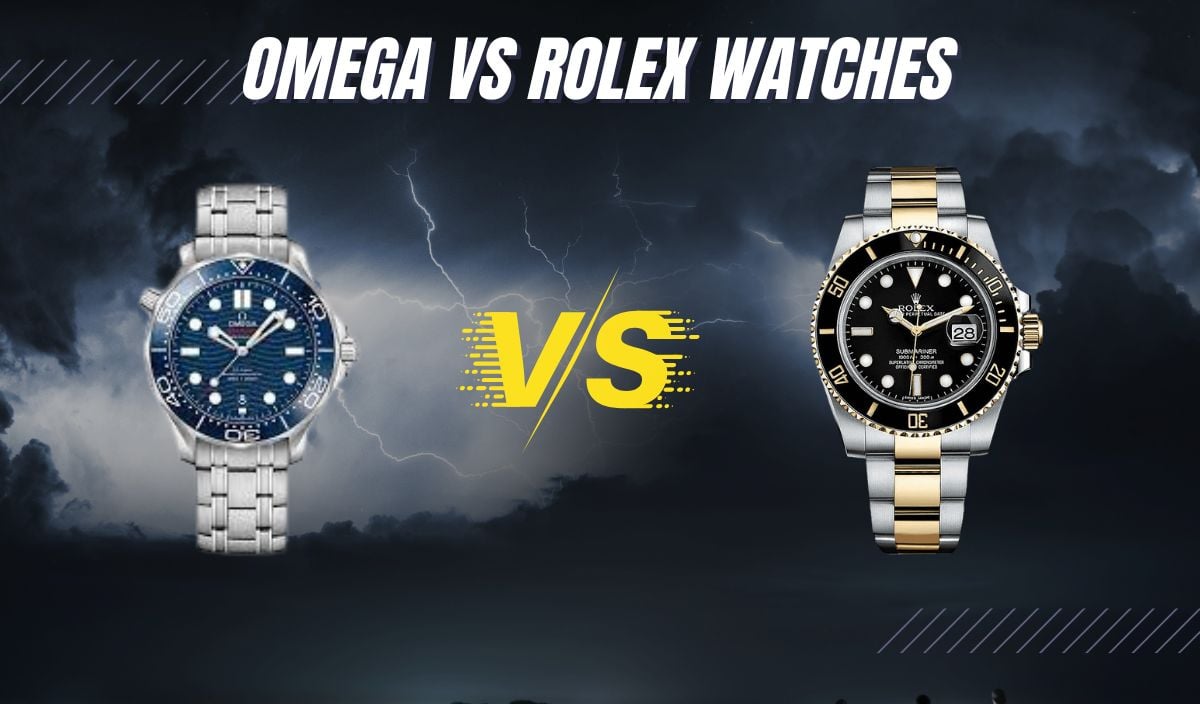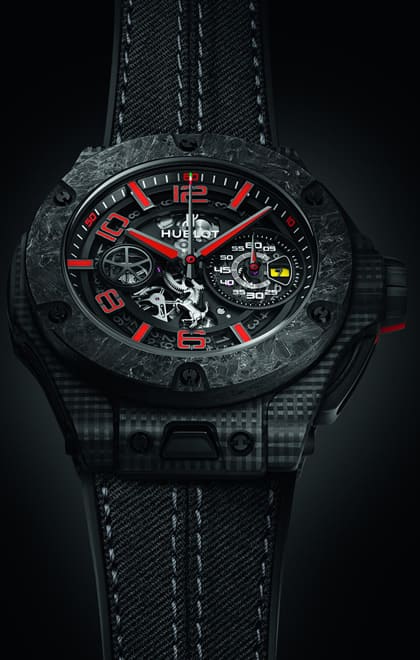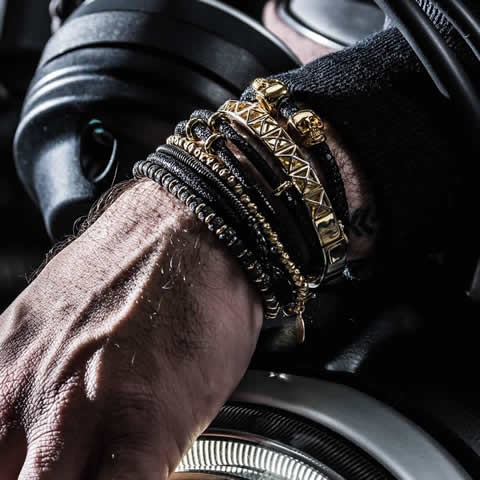
Omega vs Rolex Watches: Don’t Make The WRONG Decision!
In the world of luxury watches, two names often surface in conversations of undoubted heritage: Omega and Rolex. Both are Swiss watchmakers with a rich history and an enviable lineup of iconic models.
Models from these have graced the wrists of explorers, sportsmen, astronauts, and cinema’s most famous spy. But the question arises among enthusiasts and potential buyers, “Omega or Rolex: Which is the right watch brand for me”?
This article aims to illuminate these two world-renowned brands’ strengths, histories, and unique offerings. Comparing their brand recognition, model variety, build quality, and more, we can gain the necessary insight into the legacies of these two giants to make an informed decision on our preference.
Additionally, it’s also worth getting up close and personal with some of their most notable models. With head-to-head comparisons that scrutinize every detail, from case size to the caliber of movement and even the strap options on: the Omega Seamaster 300M vs the Rolex Submariner Date, the Omega Speedmaster vs the Rolex Daytona, and the Omega Seamaster Aqua Terra vs the Rolex Oyster Perpetual.
For anyone wondering which watch would better suit your wrist and lifestyle, diving deep into the heart of Swiss watchmaking excellence will aid their choice.
About Omega Watches
Swiss watchmaking maestro, Omega SA. With a history as captivating as its timepieces’ intricate mechanisms, Omega is a true icon of the watch world.
Omega was born in the Swiss town of La Chaux-de-Fonds in 1848, founded by Louis Brandt. The company initially operated as La Generale Watch Co., assembling precision pocket watches from parts sourced from local craftsmen. The Omega name wasn’t adopted until 1903, but oh, how it has resonated since.
Precision and quality. They mark Omega’s story. This dedication wasn’t lost on Britain’s Royal Flying Corps or the U.S. Army, who selected Omega watches for their combat units in 1917 and 1918, respectively. Even NASA couldn’t resist Omega’s allure. They chose their watches for the historic Apollo 11 mission in 1969. The brand’s precision has also earned it the role of the official timekeeper of the Olympics since 1932.
The turning point came in the 1980s when Omega merged with another Swiss watch giant, ASUAG, forming ASUAG-SSIH. This company was eventually taken over by a group of private investors and renamed Société de Microélectronique et d’Horlogerie (SMH), which became The Swatch Group in 1998. The Swatch Group now manufactures Omega, continuing its legacy alongside other esteemed brands such as Blancpain and Breguet.
Today, Omega continues to be a part of Swiss watchmaking excellence. They offer an array of collections, such as the Speedmaster, the Seamaster, and the Constellation, each with its unique appeal. Be it walking the lunar surface or adding a touch of class to James Bond. They are a statement, a history worn on the wrist, ticking tales of time.
About Rolex Watches
Rolex. The name exudes an aura of luxury, precision, and timeless elegance. The face of “Swiss watchmaking excellence”, and the “pinnacle of horological achievement.” they say. The name has become synonymous with the very idea of a luxury wristwatch.
The story of Rolex began in 1905, when a visionary entrepreneur named Hans Wilsdorf, along with his brother-in-law Alfred Davis, set out to create timepieces that were not only reliable but also elegant.
Back then, wristwatches weren’t as popular as they are today. However, Wilsdorf saw the potential for them to revolutionize the way people kept time. Rolex, originally based in London, moved its operations to Geneva, Switzerland, in 1919 to avoid heavy wartime taxes on luxury imports and exports.
From the very beginning, Rolex has been a pioneer. It introduced the world’s first waterproof wristwatch, the Rolex Oyster, in 1926. A couple of years later, Mercedes Gleitze wore this watch as she swam across the English Channel, and it kept perfect time throughout the ten-hour ordeal. This was the first of many adventures of Rolex watches, and it earned a massive reputation for the brand.
In 1931, Rolex again made history by inventing the self-winding mechanism with a Perpetual rotor. This significant innovation is now at the heart of every modern automatic watch. Later, Rolex developed the first fully functional GMT (Rolex GMT-Master) and the first wristwatch with an automatically changing date on the dial (Rolex Datejust).
Rolex stands for trailblazing innovations. It isn’t anything less than a brand dedicated to precision, durability, invention, and timeless elegance. Rolex’s impact on the watch industry is undeniable.
Omega vs Rolex Watches: The Battle of Two Iconic Swiss Watch Brands
The brands share a common heritage of precision and craftsmanship, but each has carved out its unique identity and loyal following. Let’s dive into the deep end and explore how these two titans compare in various aspects.
Brand Recognition
When it comes to brand recognition, both Omega and Rolex are renowned worldwide. Rolex, with its unmistakable crown logo, has often been associated with the rich and famous, from Hollywood A-listers to world leaders. Its reputation as a status symbol has made it a household name.
Everyone knows about Rolex, everyone desires a Rolex, but only very few can have a Rolex. Omega, on the other hand, has a reputation for precision and reliability. Its watches have been chosen by organizations such as NASA for their space missions and have been the official timekeepers for the Olympics since 1932.
The Omega Speedmaster, famously known as the “Moonwatch,” has a particularly high recognition factor due to its association with the Apollo moon landing missions. It’s one of the most iconic models ever designed, with perfectly spot-on proportions.
Model Variety
Omega and Rolex have quite the array to boast. Each brand brings its unique flavor to the table. Omega has a diverse selection of models. From the sporty Speedmaster and Seamaster collections to the elegant De Ville and Constellation lines, there is an Omega watch for every occasion.
An important note is that Omega also offers quartz movements, which widens the range of their reach among collectors.
Rolex also offers several iconic collections, including the Submariner, Daytona, and Oyster Perpetual, each with its distinctive style and features. They also have a unique range of materials and color options for their watches, driving Rolex enthusiasts crazy when looking for a new timepiece.
Build Quality & Durability
Omega and Rolex are top-tier. There are no shortcuts made. If not these two, then which brand will dedicate special effort toward qualitative metrics? Omega watches are known for their quality and durability.
The company’s adherence is evident in its co-axial escapement mechanism. It was specially designed by Omega to reduce friction within the watch movement and improve long-term reliability. They also have a number of watches that are certified as Master Chronometers, an indication of their level of precision and performance.
Rolex watches are recognized for their robustness and longevity. They use 904L stainless steel, which is more corrosion-resistant than the industry standard 316L steel. Rolex also manufactures its movements in-house and maintains one of the most strict quality control in the whole industry.
Movements
We’re talking high-quality, reliable movements here. Rolex exclusively uses in-house, automatic movements in their watches. They are known for their precision and reliability, with many achieving COSC (Contrôle Officiel Suisse des Chronomètres) certification.
Omega, on the other hand, offers both mechanical and quartz movements in their watches. Omega’s mechanical movements feature the above-mentioned co-axial escapement, that’s designed to enhance precision and stability over time. Some of Omega’s watches also carry the Master Chronometer certification.
Price & Availability
There’s nothing to sugarcoat here; both watches come with a premium price tag. However, it’s fair to say that Rolex watches are typically more expensive. The higher price point is associated with the brand’s reputation, the use of high-end materials, and the complexity of its in-house movements.
The demand is unmatched for these watches. Omega, on the other hand, offers a wider price range. It’s definitely a more accessible brand for its audience. Their diverse collection, which includes both quartz and mechanical watches, allows for various price points.
In terms of availability, Rolex watches are more challenging to find due to high demand and limited production. Omega watches are generally more readily available.
Resale Value
Historically, Rolex watches have generally had a higher resale value than Omega watches. This is primarily due to the strong brand reputation and increased demand for Rolex watches, especially specific models like the Submariner and Daytona, which can often be passed on for profit.
Omega, on the other hand, has a slightly different story. While Omega watches are highly regarded and have a strong following, they generally do not retain their value as well as Rolex watches. However, there are exceptions to this rule, especially for special or limited edition models.
Endorsements and Partnerships
Omega has cultivated a strong presence through its strategic endorsements and partnerships. Since 1932, Omega has been the official timekeeper for the Olympics. This relationship has continued for over 80 years, making it one of the longest-running partnerships in the sporting world.
Omega is also known for keeping time in space. The Omega Speedmaster was the first watch on the moon, worn by Buzz Aldrin during the Apollo 11 mission in 1969.
The Brand also had the honor of arming James Bond with class and elegance. Since 1995, Omega Seamaster watches have been featured in the James Bond films, worn by actors like Pierce Brosnan and Daniel Craig. This partnership has led to special “James Bond” editions of their watches.
Rolex has partnerships with elite golf tournaments and professional tennis events. Their watches are very eye-catching in the corner of the court at Wimbledon or the Australian Open. They have also partnered with the prestigious Yacht Club Costa Smeralda and the Rolex Sydney Hobart Yacht Race.
“Rolex Testimonees” include prominent figures from various fields. In tennis, they’ve partnered with legendary players like Roger Federer and Serena Williams. In golf, they count Tiger Woods and Phil Mickelson. In regards to the film-making industry, they have award-winning directors on their side, such as Martin Scorsese and Kathryn Bigelow.
Service and Maintenance
Omega recommends a service interval of 5 to 8 years, depending on the model and its usage. Their servicing involves the complete disassembly of the watch, thorough cleaning, replacement of worn parts, and reassembly and lubrication.
They also have an additional step in their service process – the watch movement is placed in a testing machine that simulates the conditions a watch might encounter on a wearer’s wrist.
Omega’s Co-Axial Master Chronometer watches, which are resistant to magnetic fields, undergo specific tests to ensure they retain this resistance after servicing.
Rolex recommends having their watches serviced about every 10 years, though this can depend on the model and how the timepiece is used. Like Omega, when a Rolex watch is serviced, it is completely disassembled and thoroughly cleaned, and any worn or damaged components are replaced with genuine Rolex parts.
The timepiece is also resealed to ensure it retains its water resistance. Rolex provides a two-year service guarantee, ensuring that any issues arising from the service will be corrected at no additional cost.
Omega vs Rolex Watches: Top Models Comparison
We find ourselves at the crossroads of innovation and tradition. Elegance and ruggedness. Omega and Rolex. Let’s discuss the differences between the fine details of the most iconic models of these two.
Omega Seamaster 300M vs Rolex Submariner Date
Few matchups garner as much attention as the Omega Seamaster 300M and the Rolex Submariner Date. Timeless designs, top-notch materials, and superior functionality describe these two.
The Seamaster 300M is known for its robust build and underwater prowess. It comes with a 42 mm case made of stainless steel and a unidirectional rotating bezel fashioned from ceramic, giving it a sturdy and durable exterior.
The watch is powered by Omega’s self-winding Co-Axial Master Chronometer Calibre 8800. This movement is certified by the Swiss Federal Institute of Metrology (METAS).
The Submariner Date comes with a 41mm Oystersteel case. It’s powered by the Perpetual, mechanical, self-winding Calibre 3235. The watch holds the Superlative Chronometer certification after being tested in Rolex’s own laboratories.
| Seamaster 300M | Submariner Date | |
| Case Size (Men) | 42mm | 41mm |
| Materials | Stainless steel case and ceramic bezel | Oystersteel and Cerachrom bezel |
| Water Resistance | Up to 300m | Up to 300m |
| Movement | Omega Master Chronometer Calibre 8800 with METAS certification, 55-hour power reserve | Rolex Calibre 3235, 70-hour power reserve, Superlative Chronometer certification |
| Strap | Available on a steel bracelet or a range of rubber straps | Available only on an Oystersteel bracelet |
| Additional Features | Helium escape valve, unidirectional rotating bezel, date window at 6 o’clock | Date window at 3 o’clock with Cyclops lens over the date, unidirectional rotating bezel |
| MSRP | $5,200 on a rubber strap, $5,500 on a steel bracelet | $9,550 |
Omega Speedmaster vs Rolex Daytona
There’s been a long-standing rivalry between these two chronographs. Just like in many other categories, these two dominate nearly the whole chronograph market.
While the Omega Speedmaster offers a manual winding movement and an enduring design that’s been tested by the rigorous conditions of space, the Rolex Daytona counters with its automatic chronograph movement, prestigious reputation, and strong ties to the high-octane world of auto racing.
| Speedmaster | Daytona | |
| Case Size (Men) | 42mm | 40mm |
| Materials | Stainless steel | Stainless steel |
| Water Resistance | 50 meters | 100 meters |
| Movement | Omega Caliber 3861 (manual-winding) | Perpetual Caliber 4131 (self-winding) |
| Strap | Stainless steel bracelet, leather strap, NATO strap, and rubber strap | Typically a stainless steel Oyster bracelet or option for leather straps. |
| Additional Features | Some models may include features like a moon phase complication, date function, or a tachymeter bezel for measuring speed. | Chronograph functionality, a tachymeter scale engraved on the bezel, and a highly legible dial design. |
| MSRP | $5,350 | $15,100 |
Omega Seamaster Aqua Terra vs Rolex Oyster Perpetual
Just like the other comparisons, these two are both excellent timepieces, and you can’t really go wrong with either.
Omega enthusiasts might have a hard time choosing a style here since there’s so much going on with the Seamaster Aqua Terra, while Rolex, on the other hand, might cause trouble charging double for certain models.
Are they both awesome? Yes. However, objectively speaking, Omega’s offer appears to be more technically advanced, and many say it’s the more luxurious looking of the two as well.
| Seamaster Aqua Terra | Oyster Perpetual | |
| Case Size (Men) | 38mm to 41mm | 36mm to 41mm |
| Materials | Stainless steel | Stainless steel |
| Water Resistance | 150 meters | 100 meters |
| Movement | Omega Co-Axial Caliber movement (certified as Master Chronometer) | Self-winding, Calibre 2232 or Calibre 3230 (certified as Superlative Chronometers) |
| Strap | Stainless steel bracelet and leather strap | Stainless steel Oyster bracelets |
| Additional Features | Some models feature a date function, exhibition case back, and luminescent hands and hour markers | Known for its timeless and classic design, it focuses on simplicity and reliability. Some models may have luminescent markers. |
| MSRP | $6,200 | From $5,800 |
Omega Planet Ocean 600M vs Rolex Sea-Dweller
Aquaman’s starter pack. You can literally rule the seas with these two. Being born in the heart of Switzerland, these watches will not mind a drop of water in lightly dripping weather. But in all seriousness, the Seamaster Planet Ocean by Omega and the Sea-Dweller by Rolex are two of the greatest diving watches in the world.
The similarities, though, essentially stop there. These timepieces may as well be thousands of miles apart due to their different movements and features. Who would prevail in a duel between Rolex and Omega? Let us leave that up to you.
| Planet Ocean 600M | Sea-Dweller | |
| Case Size (Men) | Ranging from 42mm to 45.5mm | 43mm |
| Materials | Stainless steel (bezel can feature materials like ceramic or Liquidmetal) | 904L stainless steel |
| Water Resistance | 600 meters | Up to 1,220 meters |
| Movement | Omega Co-Axial movement (exact caliber varies depending on size); METAS certification | Rolex Caliber 3235; Superlative Chronometer certification |
| Strap | Stainless steel bracelet, rubber strap, or NATO strap | Stainless steel Oyster bracelet |
| Additional Features | Some models may include features like a helium escape valve for professional diving or luminescent markers. | Rolex’s Glidelock extension system for easy adjustment, Rolex’s Cyclops lens, helium escape valve. |
| MSRP | $6,166 | $14,350 |
Omega Globemaster vs Rolex Datejust
The Datejust has all of the qualities of the traditional steel Rolex. Fluted bezel, cyclops, stick indices. It screams Rolex from far away. But the hype comes at a great cost. The question remains: is it worth it to pay more just to have something others desire?
The Globemaster’s specifications appear to be similar to those of many other watches at first glance: stainless steel case, blue dial (in this case), and a just-right 39mm diameter (47mm lug-to-lug). The watch delivers on the brand’s reputation without nearly as much hype and lust toward it.
| Globemaster | Datejust | |
| Case Size (Men) | 39mm or 41mm | 36mm or 41mm |
| Materials | Stainless steel (some models feature combinations of steel and precious metals like gold or platinum) | Stainless steel, two-tone (steel and gold), or solid gold |
| Water Resistance | 100 meters | 100 meters |
| Movement | Omega Co-Axial Master Chronometer movement (certified by METAS) 48 to 60 hours of power reserve |
Powered by various Rolex in-house automatic movements. COSC certified. 48 to 70 hours of power reserve |
| Strap | Leather, fabric, or metal bracelets | Oyster or Jubilee bracelet |
| Additional Features | Some models feature a distinctive pie-pan dial, Omega’s anti-magnetic technology | Iconic cyclops lens, tons of available dial and materials options, including Rolex’s patented Rolesor |
| MSRP | $7,100 | between $7,700 and $15,500 |
Conclusion
In conclusion, both Omega and Rolex offer an impressive array of watches. They cater to a wide range of tastes, preferences, and budgets. For those on the hunt for a watch with a rich history, exceptional craftsmanship, and high performance, these two brands couldn’t be more qualified for the job.
Rolex, with its unrivaled brand recognition and consistent resale value, is an excellent choice for those seeking an investment as much as a timepiece. It carries a certain prestige that’s hard to match, and its watches are renowned for their robustness and reliability.
Omega, on the other hand, offers fantastic variety, innovation, and value for money. Omega watches tend to be more accessible price-wise, and their pioneering spirit in watchmaking technology still has an undeniable appeal.
What might appear to be a simple choice for astronauts or race car drivers will remain a never-ending dilemma for the average enthusiast…
About Exquisite Timepieces
Established in 1998, Exquisite Timepieces is your one-stop shop for all things luxury watches! We are an authorized dealer for 60+ luxury watch brands including Omega, Hublot, Seiko, & Longines! We are proud to showcase one of the world’s largest pre-owned watch collections, including renowned brands like Rolex and Patek Philippe. Check out our brand new watch arrivals here and popular pre-owned listings here.








